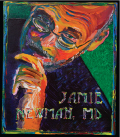Choosing unwisely
A fictionalized ED visit for a simple cut spins wildly out of control.
It was a typical Minnesota July afternoon, and it felt great to have a day off from the grind. The sun was shining, and the mosquitoes were whining. I was attending to my overgrown garden. The asparagus had shot up and turned into fine-leaved bushes. The cucumber vines spread malignantly. I was holding a small shovel in my hand when I swatted away a fly, cutting my cheek. Blood poured down my face. I took a look at myself, and when I was done screaming, I held a towel to my injury and drove to the emergency room. I hoped it was not crowded.
I had forgotten it was July: new students, new interns, new staff. I waited in the ED, hunched in a plastic chair with my face leaking, wedged between a tussive teenager and an itchy indigent. After an hour, I had to play the “staff card,” even though as a retired proctologist I wasn't up on much of modern medicine. I was ushered to the next stage in my wait. Eventually I was seen by an intern. Before talking to me, he began to order tests. Then he machine-gunned me with questions: “Are you bleeding? Have you bled in the past? Do you clot? Have you had blood clots?” He stared at his screen and ordered a CBC, INR, PTT, bleeding time, and a MTHFR genetic test for hereditary thrombophilia. I asked him who would stitch up my laceration.

“Laceration?” he queried. “Have you had your tetanus booster? Hepatitis shots? HIV testing?” The orders went in for hepatitis B antibody, tetanus booster, HIV test, and citrullinated ceruloplasmin. I was stunned. I wondered if he'd get around to closing my wound. Finally, he peered at my rather magnificent profile. “I better get a plastics consult. Wouldn't want a scar.” And so I waited once again.
The plastics resident arrived. He took one look at my face and called the OR. “Major facial laceration, may need a wound VAC.” He ordered a large wrap for my head, which covered my eyes. The intern rushed back in: “They want me to do a PAME.” I wondered what that meant. I still don't know. He ordered a chest X-ray, EKG, another CBC, an electrolyte panel, liver function tests, and another citrullinated ceruloplasmin.
The internal medicine resident came into the room. He looked more senior. He stared at the EKG. He spoke to the intern, not to me. “Suspicious bradycardia here. I don't want to clear him for surgery without an echo. Better make it a dobutamine stress echo while we are at it, just in case.” And then he said, “This man's chest X-ray shows a small granuloma. Let's get a CT chest with contrast.” I sat silently under my head wrap, wondering what was going on. The intern asked me, “Any trouble with your hearing, taste, or vision?” I mentioned I could not see, due to the large bandage. I think he ordered an ophthalmology consult, color vision testing, and a VDRL.
Finally, I was cleared and wheeled down to the OR. The team shaved my abdomen and placed a Foley catheter and a large-bore IV line. I asked who was going to sew up my face. They looked at my armband and sheepishly grinned, then walked out. A few minutes later a different team came in and began to prep my face. I still could not see due to the large bandage. I heard a snip as they removed a small amount of my hair. “Just testing for heavy metal,” the intern reassured me.
I came out of general anesthesia some time later. My face was numb, and my head was wrapped like a mummy. They admitted me to the ICU. My glucose had been high in the ED at 158, though if they had asked me, I would have told them I'd eaten a candy bar in the waiting room. I was placed on an insulin drip, then I got hypoglycemic, so I was given glucagon and D50 and then more insulin. My potassium was 3.3, so I was given 40 mEq/h of IV potassium, which burned my veins going in. I complained of pain and ended up on a PCA pump with a high basal rate. I was essentially blinded by my bandages and hypoglycemia and wasted on hydromorphone when the cardiology team came in and recommended a cardiac catheterization. The consultant said, “We would not want to miss critical stenosis in light of your equivocal echo.” They stented a 48% stenosed vessel. I felt lucky they had saved me from a heart attack.
The next morning my kidney function had deteriorated, due to the CT and catheterization. They ordered full serum and urine electrolytes, a renal ultrasound, urine and blood cultures, a kidney biopsy, and a citrullinated ceruloplasmin. I bled from the biopsy site due to my DVT prophylaxis. They gave me vitamin K and fresh frozen plasma and clotting factor concentrate. My hemoglobin dropped to 9.9, so they transfused 2 units quickly, pushing me into florid pulmonary edema, and I was intubated.
Four weeks later I finally was discharged, I was off dialysis, and my trach site looked clean. My drug rash had almost cleared, I'd regained use of my right hand, and I was only in-and-out urinary cathing myself twice a day.
I finally got the bandage off and looked at my face. They had just steri-stripped the cut. And then the phone rang. “Sir, we want to discuss a test result: Your citrullinated ceruloplasmin just came back borderline positive on 1 of 3 assays. We need to do some more testing.”



